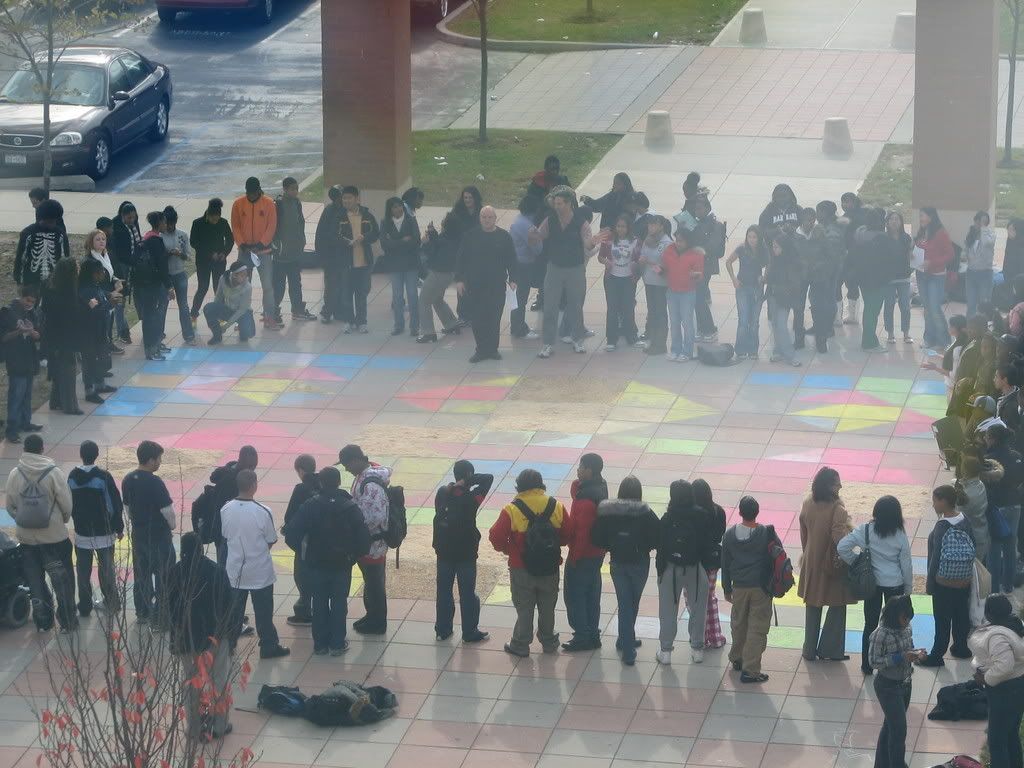http://wanderingink.wordpress.com/2007/05/23/how-to-prevent-another-leonardo-da-vinci/ While surfing other "teacher blogs" I came across this posting by Kris Bradburn. The following article which Kris Bradburn wrote has been nominated for online awards and this website is something I am adding to my "google reader"
While surfing other "teacher blogs" I came across this posting by Kris Bradburn. The following article which Kris Bradburn wrote has been nominated for online awards and this website is something I am adding to my "google reader"
This is how we kill each trait that may yield another Da Vinci:
1. Curiosita (from “How to Think Like Leonardo da Vinci”)
What? Intense and insatiable curiosity; constantly learning due to a desire to ask and answer questions
The Murder: In schools, for the most part, students learn only what the teacher decides they will learn. Student questions will often go unanswered if they lead away from the material (go off-topic), or if there are time constraints on what must be learned that leave no time for these questions in class.
2. Dimostrazione (from “How to Think Like Leonardo da Vinci”)
What? Constant testing of knowledge through experience and persistence; accepting of and learning from mistakes
The Murder: Except in the sciences (and sometimes even then), knowledge is simply given and expected to be absorbed rather than questioned and tested. On tests and labs, wrong answers cost the students their grades, therefore it becomes unacceptable to make mistakes. Mistakes are less about learning experiences and more about losing marks. Questioning societal norms is a very negative thing, even if they don’t make sense.
3. Sensazione (from “How to Think Like Leonardo da Vinci”)
What? Fully noticing and observing things with all senses, but especially sight (seeing things that others miss, seeing the details)
The Murder: Except in the sciences and a handful of other subjects, students are usually taught passively through the use of only one sense, listening, or maybe sight (diagrams, photos, etc.). Classrooms and assignments may be incredibly unstimulating to most (or all) senses.
4. Sfumato (from “How to Think Like Leonardo da Vinci”)
What? An acceptance of ambiguity, paradox, and uncertainty out of a realization that life is not black and white (also an art technique using shadow famous for its use in da Vinci’s paintings)
The Murder: A student’s answer is either right or wrong, usually with no middle ground tolerated. Standardized tests are mostly multiple choice, and in the case of an ambiguous result, students must choose the best possible answer, not a possible answer, even though more than one is really correct. Life and its problems have more than one right answer; multiple choice questions have only one best answer.
5. Arte/Scienza (From “How to Think Like Leonardo da Vinci”)
What? Interest in both the arts and sciences and interdisciplinary work that combines them
The Murder: High school courses are most often strictly defined as an “Art” or a “Science”, and they never mingle; interdisciplinary courses at this level are rare. In college, an undergraduate usually receives a either Bachelor of Arts or a Bachelor of Science, though there is more flexibility here than in high school. Scientists and artists have their own professional domains which almost never overlap.
6. Corporalita (from “How to Think Like Leonardo da Vinci”)
What? Keeping one’s body in good shape; attending to nutrition, fitness, and general physical well-being
The Murder: Physical Education programs - especially in the United States - are being severely cut, and obesity has been described as an epidemic. Junk food is readily available and sometimes may be the only option in a high school cafeteria. Fast food is cheaper and more convenient than healthier food ($4 for an entire meal at McDonald’s or $4 for a single, small-sized fruit bowl?).
7. Connessione (from “How to Think Like Leonardo da Vinci”)
What? Acceptance and appreciation for the interconnectedness of everything in life; interdisciplinary approaches and thinking
The Murder: Facts and concepts are taught in specific classes that are independent of each other, and students are moved from individual class to individual class without knowledge of how the two might be connected. Boundaries like that between art and science are rarely crossed or their connectedness even explained. Facts and ideas might be taught with no explanation of the links between them (ie, learning individual details and facts but not the big picture).
8. Drive, energy, intense focus (from various studies on creative genius)
What? Energy and desire to focus intensely on one’s work and interests (often the same thing); merging of work and play
The Murder: Each class is allotted a certain period of time that is inflexible. Despite the student’s interest in a particular class, they must conform to this schedule. Many schools have required curriculum that force a student to give up desirable or necessary electives for core classes they may not need. Students must go to school and all perform well academically, despite their individual talents and aspirations. Musicians and artists especially must break focus on their real interests to attend required academic classes, and may be too drained to work on their own by the end of the school day.
9. Confidence, willingness to take risks, and tolerance of failure (from various studies on creative genius)
What? Willing to continue on with creative work despite rejection; ability to sell oneself and one’s talents
The Murder: Many creative people must face multiple rejections until their idea is sold, and they must accept that if their idea or creative contribution is too radical, society may not yet be ready for it (many artists and writers have only been recognized after their deaths). However, as mentioned above, mistakes and failure are not tolerated in schools and this learned attitude may carry on throughout life. Instead of learning the value of taking risks, students are taught to fear any mistakes that might result. Students are often “babied” - all team mates get a ribbon or a trophy for “participation” - and do not gain the real-world skills they need to sell themselves.
10. Independence, introversion (from various studies on creative genius)
What? Willingness to spend lots of time alone working and honing skills; acceptance of possible isolation
The Murder: The social climate of high school severely discourages spending time alone, especially when spent “working”, and loners are isolated and considered antisocial and friendless. Refusing to conform and “sticking out from the crowd” is highly discouraged by peers and teachers. Creative individuals may have to accept that if the world is not ready for their ideas, they may find few people who understand and support them.
This is how we kill the spirits of our up-and-coming da Vincis. These ten things are the most commonly cited characteristics of highly creative people… and they’re heavily discouraged in the early years by the education system and social climate of adolescence. This is why we won’t see another da Vinci for a long, long time - or why, if we do, he/she would not have come from the system we currently have in place. At every turn schools and society are set on pushing back the most creative individuals. Their common traits are not welcomed nor encouraged, and certainly not nurtured. This must not persist, because I think the world is long overdue for another da Vinci-type right now.
I would love readers to share their thoughts!!!!!!!!!!!!!!!!











